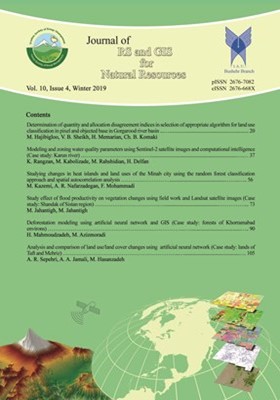Study effect of flood productivity on vegetation changes using field work and Landsat satellite images (Case study: Shandak of Sistan region)
Subject Areas : Agriculture, rangeland, watershed and forestryMansour Jahantigh 1 , Moien Jahantigh 2
1 - Assoc. Prof. Department of Soil Conservation and Water Management, Sistan Agriculture, Education and Extension Natural Resources Research Center, AREEO, Zabol, Iran
2 - PhD Student of Watershed Management Department, Faculty of Rangeland & Watershed Management, Gorgan University of Agricultural Sciences and Natural Resources, Iran
Keywords: Sistan, Soil adjusted vegetation index (SAVI), Soil water index (SWI), Vegetation cover, Landsat,
Abstract :
The object of this research is evaluated of flood productivity on vegetation cover changes. For this purpose, 5 linear transects with a length of 50 m were installed before flooding in the year 2006. In each of these transects, two plots 3×3 were identified at a height of 50 m at the beginning and 1% in length, and within each of them a plot of 1×1 was laid out for uniform harvesting at equal distances, their coordinates using specific GPS and feature the percentages of canopy cover, forage production, bare soil percentage, density and litter before starting flood spreading in 2003 were estimated. In addition, the vegetation characteristic changes were measured in the same place after the flood propagation in the year 2019. Landsat satellite images for a period of 16 years (2003-2019) was also used to study vegetation changes before and after flood propagation. For this purpose, after applying pre-processing on the images, the vegetation index was adjusted according to the soil adjusted vegetation index (SAVI) and soil water index (SWI) over five different time periods. Field results showed that with the application of flood propagation application, the amount of forage production increased from 68 to kg/ha, the percentage of canopy cover increased from 5.9 to 31.4%, as well as the amount of litter from 2 to 16.8% and bare soil decreased from 92.1 to 51.8%. Statistical analysis of vegetation characteristics before and after flood propagation revealed a significant difference between these parameters (p<0.01). In addition, the results showed significant changes in the SAVI and SWI indices over the period. The SAVI and SWI indices increased from 0.027 and 0.5 in the year 2003 to 0.49 and 1 in the year 2019, respectively, and the trend of changes in these indices showed high correlation (R² = 0.65) in flood propagation area. The results of this study showed that flooding productivity by providing soil moisture in the study area improved germination and plant growth conditions, which resulted in the establishment and improvement of vegetation cover in the floodplain.


